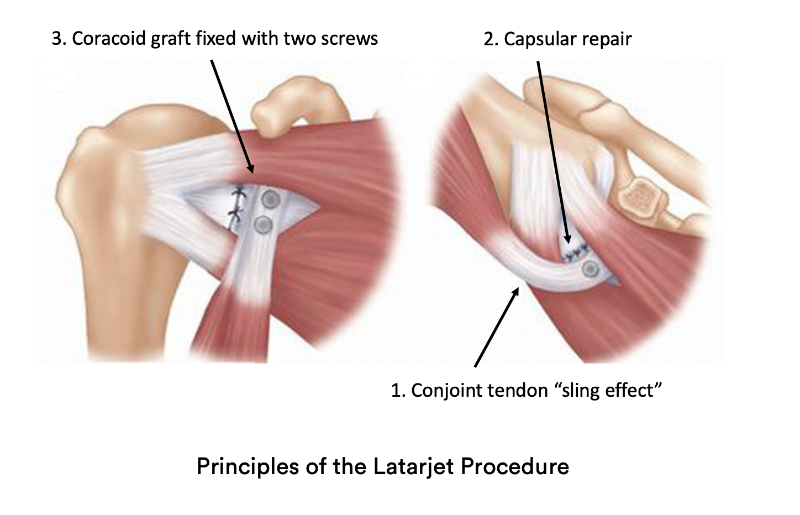- Home
- Laterjet Procedure For Shoulder Dislocation
Laterjet Procedure For Shoulder Dislocation
Laterjet Procedure For Shoulder Dislocation
The Latarjet procedure is ideal for those with complex shoulder dislocations with bone loss, failed shoulder stabilisations, and/or high level athletes (particularly collision or overhead contact). The surgery is more involved than a keyhole labral repair; however, post-operative pain and rehabilitation is much the same. Strengthening and training for your sport commences at 3 months and full, unrestricted contact is possible at 6 months after surgery.

Who is the Latarjet procedure suitable for?
A Latarjet procedure involves transferring a piece of bone (coracoid) to the front of your glenoid (socket) to address shoulder instability (dislocations out the front). There are three reasons why this operation works so well:
- Sling effect (from the conjoint tendon)
- Capsule/labral repair
- Coracoid bone block at the front of the shoulder
This operation works well in the following conditions:
- Excessive glenoid (socket) bone loss – either a large acute bony bankart (glenoid fracture) or chronic bony bankart with gradual glenoid erosion
- Large Hill-Sachs lesion (Humeral head bone loss)
- High-level athletes (e.g. rugby, touch rugby, AFL, and other contact sports)
- Overhead contact type sportspersons
- Revision shoulder stabilisation (failed keyhole procedure)
BOOK AN APPOINTMENT
You Don't Have To Live With Pain
Dr. Rahul Bade is a specialist Knee & Shoulder Surgeon.
When is it suitable to consider a Latarjet procedure?
The unstable shoulder
- Repeat anterior instability/dislocations can lead to a fear of using the shoulder (not “trusting” it) and reduction in function. Patients may avoid positions of “apprehension”.
Return to sport
- Active individuals who wish to return to sport should consider surgery to repair torn Labrum. This will allow the ligaments to heal in the correct position. A torn Labrum, without surgery, will not heal itself.
- The published return to sport rate after shoulder stabilisation surgery (key-hole) is 70-90%. With stabilisation surgery, patients are 5-6 times more likely to return to play than without surgery.
Anterior Tear
- Patients will have apprehension with the hand in the upper outer quadrant
- Inability to play overhead contact sports without instability +/- pain
Prevent post-traumatic arthritis
- Repeat shoulder dislocations may damage the cartilage in the shoulder joint; this, in turn, leads to a higher risk of arthritis
- The published literature supports that shoulder stabilisation will reduce the risk of post-traumatic arthritis
- This is especially important in younger patients
What is the rehabilitation after a Latarjet procedure?
There are three essential components to a good outcome from surgery
- Your surgeon
- You as a patient
- Your physiotherapist
Post-operative physiotherapy
Dr Pant utilises the JPL pathway for most patients and this will form the basis of your rehabilitation after surgery; it will be modified to suit your individual circumstance.
The JPL pathway allows for self-directed, early passive shoulder range of movement:
- Passive = assisted with your other arm
- Active = you move the affected arm independently
Therapy overview
After the surgery you will be in a sling and protect your shoulder to allow the Latarjet procedure (coracoid bone graft) to heal. At two weeks after the surgery Dr Pant will see you at your review appointment and discuss the JPL rehabilitation protocol with you. This JPL physiotherapy protocol will commence two weeks after your surgery.
The therapy program will focus on flexibility and range of motion exercises initially. These gentle stretches will improve your range of motion and prevent shoulder stiffness. As the bone graft begins to heal you will be able to progress to exercises that strengthen your shoulder muscles. Shoulder strengthening is commenced at 12 weeks post Latarjet surgery.
Sling
- A “special” sling is required for the first 6 weeks after your surgery (see below)
- A “standard” sling is worn for a further 6 weeks outside of the house (to remind others you have had shoulder surgery)


